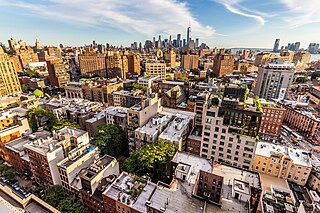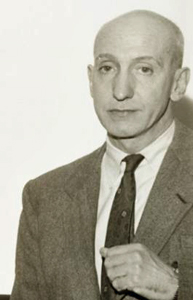Related Research Articles
Abstract expressionism in the United States emerged as a distinct art movement in the immediate aftermath of World War II and gained mainstream acceptance in the 1950s, a shift from the American social realism of the 1930s influenced by the Great Depression and Mexican muralists. The term was first applied to American art in 1946 by the art critic Robert Coates. Key figures in the New York School, which was the center of this movement, included such artists as Arshile Gorky, Jackson Pollock, Franz Kline, Mark Rothko, Norman Lewis, Willem de Kooning, Adolph Gottlieb, Clyfford Still, Robert Motherwell and Theodoros Stamos among others.
Action painting, sometimes called "gestural abstraction", is a style of painting in which paint is spontaneously dribbled, splashed or smeared onto the canvas, rather than being carefully applied. The resulting work often emphasizes the physical act of painting itself as an essential aspect of the finished work or concern of its artist.
The New York School was an informal group of American poets, painters, dancers, and musicians active in the 1950s and 1960s in New York City. They often drew inspiration from surrealism and the contemporary avant-garde art movements, in particular action painting, abstract expressionism, jazz, improvisational theater, experimental music, and the interaction of friends in the New York City art world's vanguard circle.

Elaine Marie Catherine de Kooning was an Abstract Expressionist and Figurative Expressionist painter in the post-World War II era. She wrote extensively on the art of the period and was an editorial associate for Art News magazine.

Color field painting is a style of abstract painting that emerged in New York City during the 1940s and 1950s. It was inspired by European modernism and closely related to abstract expressionism, while many of its notable early proponents were among the pioneering abstract expressionists. Color field is characterized primarily by large fields of flat, solid color spread across or stained into the canvas creating areas of unbroken surface and a flat picture plane. The movement places less emphasis on gesture, brushstrokes and action in favor of an overall consistency of form and process. In color field painting "color is freed from objective context and becomes the subject in itself."

Ethel Kremer Schwabacher was an influential abstract expressionist painter, represented by the Betty Parsons Gallery in the 1950s and 1960s. She was a protégé and first biographer of Arshile Gorky, and friends with many of the prominent painters of New York at that time, including Willem de Kooning, Richard Pousette-Dart, Kenzo Okada, and José Guerrero. She was also the author of a monograph on the artist John Charles Ford and a memoir, "Hungry for Light".

The 9th Street Art Exhibition of Paintings and Sculpture is the official title artist Franz Kline hand-lettered onto the poster he designed for the Ninth Street Show. Now considered historic, the artist-led exhibition marked the formal debut of Abstract Expressionism, and the first American art movement with international influence. The School of Paris, long the headquarters of the global art market, typically launched new movements, so there was both financial and cultural fall-out when all the excitement was suddenly emanating from New York. The postwar New York avant-garde, artists like Willem de Kooning and Jackson Pollock, would soon become "art stars," commanding large sums and international attention. The Ninth Street Show marked their "stepping-out," and that of nearly 75 other artists, including Harry Jackson, Helen Frankenthaler, Michael Goldberg, Joan Mitchell, Grace Hartigan, Robert De Niro Sr., John Ferren, Philip Guston, Elaine de Kooning, Lee Krasner, Franz Kline, Ad Reinhardt, David Smith, Milton Resnick, Joop Sanders, Robert Motherwell, Barnett Newman, and many others who were then mostly unknown to an art establishment that ignored experimental art without a ready market.

Roy Newell (1914-2006) was an American abstract painter.

New York Figurative Expressionism is a visual arts movement and a branch of American Figurative Expressionism. Though the movement dates to the 1930s, it was not formally classified as "figurative expressionism" until the term arose as a counter-distinction to the New York–based postwar movement known as Abstract Expressionism.
Michael Goldberg was an American abstract expressionist painter and teacher known for his gestural action paintings, abstractions and still-life paintings. A retrospective show, "Abstraction Over Time: The Paintings of Michael Goldberg", was shown at MOCA Jacksonville in Florida from 9/21/13 to 1/5/14. His work was seen in September 2007 in a solo exhibition at Knoedler & Company in New York City, as well as several exhibitions at Manny Silverman Gallery in Los Angeles. Additionally, a survey of Goldberg's work is exhibited at the University Art Museum at California State University, Long Beach since September 2010.
Madison Fred Mitchell belonged to the New York School Abstract Expressionist artists whose influence and artistic innovation by the 1950s had been recognized around the world. New York School Abstract Expressionism, represented by Jackson Pollock, Willem de Kooning, Franz Kline and others became a leading art movement of the post-World War II era.

20th-century Western painting begins with the heritage of late-19th-century painters Vincent van Gogh, Paul Cézanne, Paul Gauguin, Georges Seurat, Henri de Toulouse-Lautrec, and others who were essential for the development of modern art. At the beginning of the 20th century, Henri Matisse and several other young artists including the pre-cubist Georges Braque, André Derain, Raoul Dufy and Maurice de Vlaminck, revolutionized the Paris art world with "wild", multi-colored, expressive landscapes and figure paintings that the critics called Fauvism. Matisse's second version of The Dance signified a key point in his career and in the development of modern painting. It reflected Matisse's incipient fascination with primitive art: the intense warm color of the figures against the cool blue-green background and the rhythmical succession of the dancing nudes convey the feelings of emotional liberation and hedonism.

American Figurative Expressionism is a 20th-century visual art style or movement that first took hold in Boston, and later spread throughout the United States. Critics dating back to the origins of Expressionism have often found it hard to define. One description, however, classifies it as a Humanist philosophy, since it is human-centered and rationalist. Its formal approach to the handling of paint and space is often considered a defining feature, too, as is its radical, rather than reactionary, commitment to the figure.

Mary Lee Abbott was an American artist, known as a member of the New York School of abstract expressionists in the late 1940s and 1950s. Her abstract and figurative work were also influenced by her time spent in Saint Croix and Haiti, where she lived off and on throughout the 1950s.
Seymour Boardman (1921–2005) was a New York abstract expressionist. Since his first solo exhibition in Paris in 1951, Boardman developed a personal vision and style of his own, following his own path of abstraction. As a painter he sought to reduce the image to its bare essence.

Sonia Gechtoff was an American abstract expressionist painter. Her primary medium was painting, but she also created drawings and prints.
Philip Pavia (1911-2005) was a culturally influential American artist of Italian descent, known for his scatter sculpture and figurative abstractions, and the debate he fostered among many of the 20th century's most important art thinkers. A founder of the New York School of Abstract Expressionism, he "did much to shift the epicenter of Modernism from Paris to New York," both as founding organizer of The Club and as founder, editor and publisher of the short-lived but influential art journal It Is: A Magazine for Abstract Art. Reference to the magazine appears in the archives of more than two dozen celebrated art figures, including Picasso, Peggy Guggenheim, and art critic Clement Greenberg. The Club is credited with inspiring art critic Harold Rosenberg’s influential essay “The American Action Painters" and the historic 9th Street Show.

George McNeil was an American abstract expressionist painter.
The Club has been called "a schoolhouse of sorts ... as well as a theater, gallery space, and a dancehall...." Created by abstract expressionist sculptor Philip Pavia, The Club grew out of the informal gatherings among dozens of painters and sculptors who all had art studios in Lower Manhattan between 8th and 12th streets and First and Sixth Avenues during the late 1940s and early 1950s. Membership included many of New York's most important mid-century artists and thinkers, predominantly painters and sculptors like Willem de Kooning, Franz Kline, Isamu Noguchi, John Ferren, and Robert Motherwell, as well as nearly all the artists later called the New York School. But other celebrated artists, cultural figures and major 20th-century thinkers attended meetings, including philosopher Joseph Campbell, composer John Cage and political theorist Hannah Arendt. Structured to facilitate the growth and dissemination of ideas about art by artists for artists, especially abstract expressionist art, The Club lent New York's art scene the vitality and international influence Paris had long monopolized, and U.S. artists had long craved.
It is. A Magazine for Abstract Art was an influential limited edition fine arts magazine that only published six issues in its seven years of existence. Founded by the abstract expressionist sculptor Philip Pavia, the magazine's contributors included a who's who of some of the 20th century's most important artists. Although it primarily focused on painters and sculptors like Willem de Kooning, Franz Kline, Helen Frankenthaler, Jackson Pollock and Isamu Noguchi, it also published artists of other kinds, like musician John Cage and poet Allen Ginsberg. Collectively, the magazines served to catalyze, and catalogue, the contemporaneous life cycle of abstract expressionist thought, from creation to mature expression. Reference to the magazine appears in the archives of Picasso, Motherwell and André Breton, as well as collector Peggy Guggenheim, critic Clement Greenberg and nearly two dozen others.
References
- 1 2 "Natalie Edgar Paintings from the Last Decade". Art net.com. Retrieved Feb 6, 2019.
- 1 2 Edgar, Natalie (Oct 28, 2015). "Natalie Edgar Archives". ARTnews. Retrieved Feb 6, 2019.
- ↑ "Natalie Edgar". Wide Walls. Retrieved Jan 25, 2019.
- ↑ Cascone, Sarah (Dec 8, 2017). "At Art Miami, Mark Borghi Celebrates Women Artists Who Broke the Rules". Artnet News. Retrieved Jan 25, 2019.
- ↑ Benton, William (Apr 2, 2012). "Natalie Edgar: Abstract Journey". The Brooklyn Rail. Retrieved Nov 13, 2018.
- ↑ "Between Picture and Viewer: The Image in Contemporary Painting". MutualArt.com. Retrieved Feb 3, 2019.
- 1 2 "Natalie Edgar". Ask Art. Retrieved Feb 3, 2019.
- ↑ Edgar, Natalie (Oct 1965). "Retrospective: The Satisfactions of Robert Motherwell". ARTnews.
- ↑ Edgar, Natalie (2007). Club Without Walls. Midmarch Arts Press. ISBN 978-1877675645.
- ↑ "Philip Pavia and Natalie Edgar archive of abstract expressionist art, 1913–2005". Emory Libraries and Information Technology. 13 October 2009. Retrieved Jan 25, 2019.
- ↑ Brown, Devin (Aug 15, 2013). "On Not Becoming Loners and Fading Away: An Overview of the Philip Pavia and Natalie Edgar Archive of Abstract Expressionist Art". Burnaway: The Voice of Art in the South. Retrieved Jan 25, 2019.
- ↑ Hellstein, Valerie. "Abstract Expressionism's Counterculture: The Club, the Cold War, and the New Sensibility" (PDF). MOMA. Retrieved Nov 13, 2018.
- ↑ Gabriel, Mary (2017). Ninth Street Women: Lee Krasner, Elaine de Kooning, Grace Hartigan, Joan Mitchell, and Helen Frankenthaler: Five Painters and the Movement That Changed Modern Art. New York: Little, Brown and Company. ISBN 978-0316226189.
- ↑ Sisario, Ben (Apr 15, 2005). "Philip Pavia, 94, an Avant-Garde Sculptor, Is Dead". The New York Times. Retrieved Feb 6, 2019.
- ↑ "Luigi Pavia, 44, 'a Talent for Friendship'". The East Hampton Star. Sep 20, 2012. Retrieved Jan 25, 2019.
- ↑ Segal, Mark (Jan 19, 2017). "Paul Pavia's Small Sculptures Recall Great Monoliths". The East Hampton Star. Retrieved Jan 25, 2019.